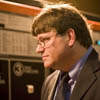Whether because of a recent spate of Hollywood disaster films or a recent spate of disastrous weather, or perhaps some combination of both, a popular nonfiction subgenre has emerged over the past decade: the tornado thriller. Recent books have chronicled the tornado that hit Joplin, Missouri, in 2011; historic tornado outbreaks of 1925 and 1974; and the allure and dangers of tornado-chasing. The two gold standards of bad weather in nonfiction, Sebastian Junger’s The Perfect Storm and Erik Larsen’s Isaac’s Storm, defined the combination of meteorological research and breathless action sequences that recent twister books have sought to achieve. The latest entry into the field may come the closest to the mark of any yet published: What Stands in a Storm, the first book from Alabama journalist Kim Cross.
 An editor-at-large for Southern Living magazine, Cross expertly follows the unrelenting march of a line of killer tornados that traveled the American South on April 27, 2011, killing 324 people and causing $11 billion in damage. The outbreak was the culmination of a superstorm that spawned 349 tornados over the course of three days, most famously cutting a swath of destruction through Tuscaloosa near the campus of the University of Alabama. Although the widespread tornados affected millions of people, Cross wisely follows the structure of the best weather books, sticking to a few central characters who represent a cross-section of victims. She tells their stories in intense segments that begin before the disaster, move to the moments when all hell breaks loose, and follow through to the aftermath and recovery. A typical sample:
An editor-at-large for Southern Living magazine, Cross expertly follows the unrelenting march of a line of killer tornados that traveled the American South on April 27, 2011, killing 324 people and causing $11 billion in damage. The outbreak was the culmination of a superstorm that spawned 349 tornados over the course of three days, most famously cutting a swath of destruction through Tuscaloosa near the campus of the University of Alabama. Although the widespread tornados affected millions of people, Cross wisely follows the structure of the best weather books, sticking to a few central characters who represent a cross-section of victims. She tells their stories in intense segments that begin before the disaster, move to the moments when all hell breaks loose, and follow through to the aftermath and recovery. A typical sample:
Patti Parker ran up, breathless, to find the front of her house shorn off, the scraps of her walls heaped on the porch. She began screaming for her husband.
“Randy!”
The past and future dangled in the moment, her whole world in limbo, suspended in the purgatory of uncertainty. Somewhere under the house lay three pieces of her heart. They were alive. Or they were dead.
A movement on the side of the house caught her eye, and within seconds the world had shifted again. It was Johnny, walking around from the back. She could hear Randy’s voice, and it sounded strong. Then Chloe emerged through a gap in the wall and sobbed when she saw her mother. They all ran to one another and embraced, sinking gratefully to the ground in a knot of elbows and tears.
These sequences read so much like accomplished fiction that Cross felt compelled to preface the book with a note outlining her reporting method: “Any dialog in quotation marks was taken directly from an audio or video recording,” she explains, “or from transcribed interviews in which those conversations were recounted directly to me.” Cross compiled more than a hundred hours of interviews with “responders, meteorologists, survivors, and the families of those who died”—a journalistic investment that’s reflected in the book’s exquisite level of detail. In some cases, dialog is supplemented with verbatim text messages and emails exchanged by those in the storm’s path.
While the book shares useful information about the science of tornados and the professions of those who track and respond to them, no informational block is allowed to carry on for long before the narrative returns to a scene of gripping action. In total effect, the book resembles not only the best recent models of storm reporting, but a nearly seventy-year-old masterpiece that covered an entirely different sort of disaster: John Hersey’s Hiroshima.
In that book, Hersey humanized the horrors of atomic warfare by carefully interviewing and telling the true stories of six survivors of the bombing of Hiroshima; he galvanized the world with simple scenes of description, dialog, and action. Kim Cross has done the same thing for the Americans who live in Tornado Alley, those who stand directly in the crosshairs of an increasingly volatile climate. What Stands in a Storm offers both page-turning entertainment and frightening, beautifully reported reality.

Michael Ray Taylor teaches journalism at Henderson State University in Arkadelphia, Arkansas. He is the author of several books of nonfiction and coauthor of a forthcoming textbook, Creating Comics as Journalism, Memoir and Nonfiction.
Tagged: Nonfiction





